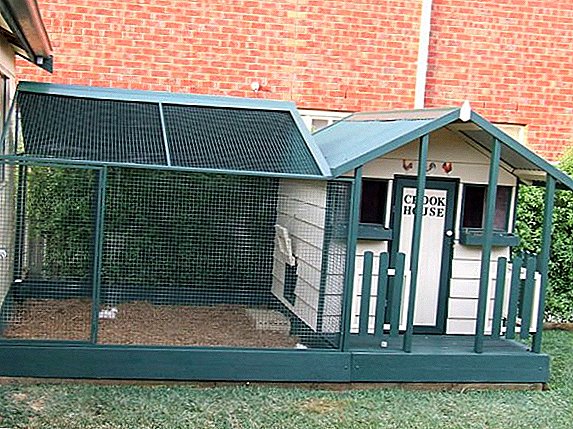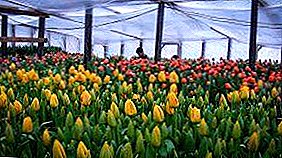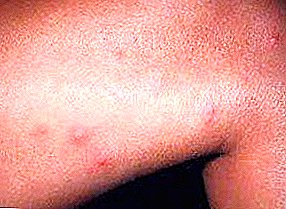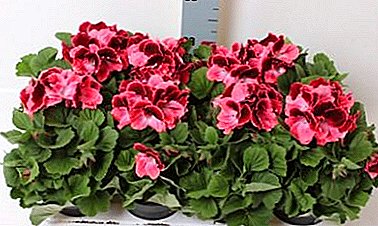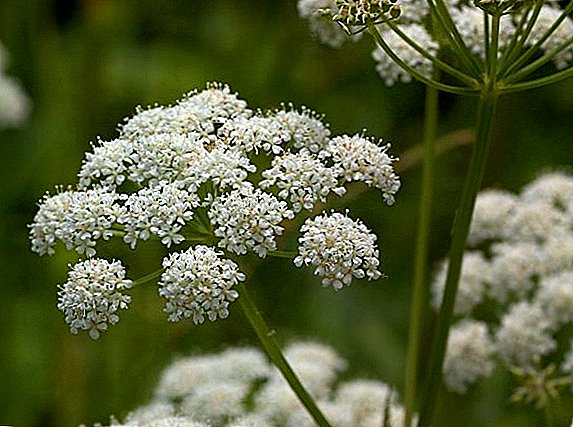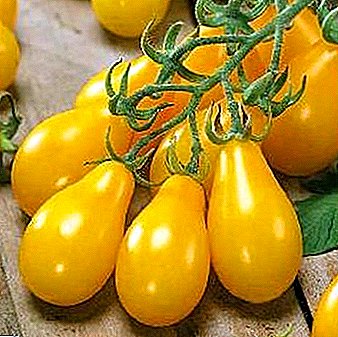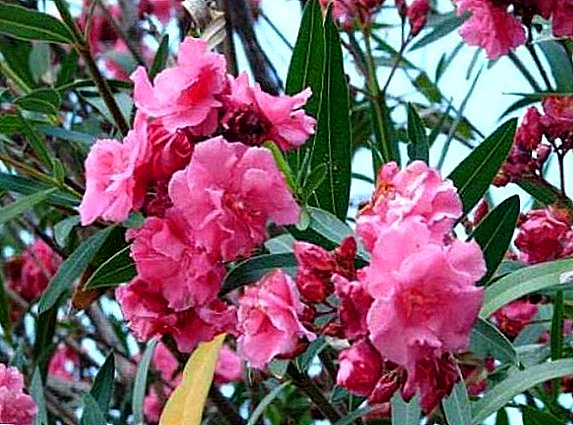 Oleander is an evergreen plant of the kutrov family. It has beautiful bright flowers of various colors and dark green narrow leaves. There are many legends associated with this representative of the flora, folk signs and superstitions. Despite the toxicity of the shrub, in the subtropics it is widely used in landscape design. At home, indoor oleander is most often cultivated.
Oleander is an evergreen plant of the kutrov family. It has beautiful bright flowers of various colors and dark green narrow leaves. There are many legends associated with this representative of the flora, folk signs and superstitions. Despite the toxicity of the shrub, in the subtropics it is widely used in landscape design. At home, indoor oleander is most often cultivated.
Care oleander ordinary
Oleander is unpretentious in care, but it should be borne in mind that it is a fast-growing, highly branchy shrub that grows up to 2 m in height. In addition, it has a strong aroma.
Important! It is better to put this pot in a spacious, bright, well-ventilated room without drafts.
Lighting and temperature
Since in natural conditions oleander grows in a subtropical climate under direct sunlight, in order to grow oleander at home, it should be provided with abundant lighting. Suitable for placement on the south windows. In winter, in cloudy weather and when placed on the north windows, you need to take care of additional lighting with fluorescent lamps. Otherwise, the shrub will fold foliage.
 Maintain air temperature from + 20-27 ° С during the growing season and flowering (spring - summer), in September gradually lower the temperature to + 18 ° С and then to + 15 ° С. During the rest period (winter) of the plant, set the temperature within + 8-15 ° С. Since the beginning of spring, gradually raise it.
Maintain air temperature from + 20-27 ° С during the growing season and flowering (spring - summer), in September gradually lower the temperature to + 18 ° С and then to + 15 ° С. During the rest period (winter) of the plant, set the temperature within + 8-15 ° С. Since the beginning of spring, gradually raise it.
Watering and spraying
In the spring and summer, the oleander needs abundant and frequent (as soon as the topsoil dries out) watering. On particularly hot days it is permissible to leave water in the pan. Spray the plant is not necessary.
In winter, the roots of the shrub poorly absorb moisture, so you should water it a couple of days after the top substrate ball dries. If the air is overdried due to heating, then it is necessary to spray the oleander, otherwise the tips of the leaves will dry out.
Important! For irrigation and spraying, use separated, soft, warm water, 2-3 ° C above room temperature. But do not boil it - watering with boiled water will lead to acidification of the soil and various diseases.
Fertilizer and pruning
 Fertilizer is applied every 2 weeks from mid-spring until the end of summer. Use alternately organic and complex fertilizers for flowering plants. Feed up on cool, cloudy days half an hour after watering. In autumn and winter they do not fertilize.
Fertilizer is applied every 2 weeks from mid-spring until the end of summer. Use alternately organic and complex fertilizers for flowering plants. Feed up on cool, cloudy days half an hour after watering. In autumn and winter they do not fertilize.
Since the flowers are formed only on the shoots of annuals, it is worth knowing how and when to trim the oleander at home. Pruning spend after shrub faded (usually in the second half of the summer). Branches should be cut in half or even 2/3 of the length.
Did you know? There are opinions that oleander cleans the house, absorbing negative energy, helps to make profitable decisions and awakens the inner strength of a person, and ornaments in the form of an oleander flower possess magical qualities and contribute to the achievement of goals.
Soil selection and transplanting
The soil for oleander should be drained, loamy (~ 6 pH). It is better that the substrate consisted of sand, peat, humus, leaf and sod land in a ratio of 1: 1: 1: 1: 2. You can add horn chips.
It is worth replanting in the late spring - early summer. Young plants are transplanted every year in small containers. Mature - as the earth is covered with earthy coma (every 2-3 years). Before the oleander is transplanted, its roots are greatly shortened, the sections are treated with charcoal, and the earthen breast is slightly reduced. When the plant becomes too large to transplant, you can simply replace the topsoil with a new one.
Oleander wintering
As already mentioned, the oleander winters at a temperature no higher than + 15 ° C, but needs good lighting. If the plant does not receive enough light, then it may not bloom in the summer, or even completely reset the foliage. Watering should be reduced, but spraying with warm water is allowed at low humidity. Fertilizers do not contribute.
Precautions in the care of the bush
 Since oleander juice contains cardiac glycosides, it is a poisonous plant, and it is very important not to neglect safety when it comes in contact with it. Do not let the juice on the mucous membranes, opening wounds, eyes. After leaving or any contact with the plant, be sure to wash your hands with soap and water. Use gloves when transplanting and trimming. It is also dangerous to stay close to a flowering shrub for a long time, and even more so to spend the night with him in the same room: you can not only earn a headache, but also get poisoned by the smell. It is better not to start an oleander in a house where there are children.
Since oleander juice contains cardiac glycosides, it is a poisonous plant, and it is very important not to neglect safety when it comes in contact with it. Do not let the juice on the mucous membranes, opening wounds, eyes. After leaving or any contact with the plant, be sure to wash your hands with soap and water. Use gloves when transplanting and trimming. It is also dangerous to stay close to a flowering shrub for a long time, and even more so to spend the night with him in the same room: you can not only earn a headache, but also get poisoned by the smell. It is better not to start an oleander in a house where there are children.
Did you know? Signs of oleander poisoning include dilated pupils, accelerated pulse, nausea, dizziness and vomiting, abdominal pain and diarrhea (bloody), then the heartbeat slows down, becomes irregular, the pressure drops, followed by cardiac arrest and respiration.
Reproduction of a room oleander
Reproduction of oleander can be carried out by cuttings, air layouts or seeds.
Cuttings
 Cutting is carried out in spring or autumn. The apical, non-lignified cutting is cut at 10–15 cm long, the cut is treated with charcoal, then dried. Root should be in perlite with the addition of sand and charcoal. Also sand and charcoal sprinkle root collar. It is important to ensure that the soil is not too moist. Shanks need good lighting and air temperature within + 18-20 ° C.
Cutting is carried out in spring or autumn. The apical, non-lignified cutting is cut at 10–15 cm long, the cut is treated with charcoal, then dried. Root should be in perlite with the addition of sand and charcoal. Also sand and charcoal sprinkle root collar. It is important to ensure that the soil is not too moist. Shanks need good lighting and air temperature within + 18-20 ° C.
Saplings can take root in water with the addition of crushed charcoal. After 20-30 days, the roots will appear, and it will be possible to transplant the oleander into small (about 8 cm in diameter) containers.
Air layouts
If you decide to use this method of reproduction of oleander, then make on the branch 2 circular incisions at a distance of 2-3 mm and remove the ring of the skin. Place the rooting in wet sand or a container of water. After the roots appear, carefully separate the layers from the mother plant and plant them in the soil.
Seeds
 Since this shrub has low germination, it is necessary to plant oleander seeds immediately after harvest. The seed is pretreated: soaked for 30 minutes in a weak solution of potassium permanganate, and then for an hour in a growth stimulator. Seeds are sown superficially in moist soil containing sand, vermiculite and charcoal. Tanks are stored in a warm place (+ 32-35 ° C).
Since this shrub has low germination, it is necessary to plant oleander seeds immediately after harvest. The seed is pretreated: soaked for 30 minutes in a weak solution of potassium permanganate, and then for an hour in a growth stimulator. Seeds are sown superficially in moist soil containing sand, vermiculite and charcoal. Tanks are stored in a warm place (+ 32-35 ° C).
After the seedlings germinate, they need to be illuminated with fluorescent lamps, provide increased soil moisture and from time to time be aired. When the first 2-3 leaves appear, the seedlings begin to adapt to the conditions in which adult plants contain; after the appearance of 4-5 leaves, they dive into separate vases. Since the propagation of seeds by varietal characteristics are not transmitted, this method is not popular.
Healing properties of oleander
Oleander is a medicinal plant, because its leaves and flowers contain a number of active, potent substances - flavonoids, cornerin, digitalin, oleandrin, ursolic acid and saponin carobin. They are used in the manufacture of drugs used in the treatment of circulatory failure І and ІІ degree, arrhythmia, to lower blood pressure, improve liver function, enhance immunity.
Possible pests of oleander ordinary and methods of dealing with them
Oleander is most often affected by the red spider mite, mealybug, and shieldweed.
 The most dangerous of the oleander pests is the spider mite. A thin cobweb testifies to the defeat of the plant by it, the leaves appear to become marble, turn yellow and fall. To combat this pest, it is necessary to remove all the leaves affected by the tick, wipe the rest with a soap solution or alcohol-containing liquid and put the oleander under a hot shower (+ 50 ° C). In severe cases, a 0.15% solution of special chemicals, such as Aktellika, is used.
The most dangerous of the oleander pests is the spider mite. A thin cobweb testifies to the defeat of the plant by it, the leaves appear to become marble, turn yellow and fall. To combat this pest, it is necessary to remove all the leaves affected by the tick, wipe the rest with a soap solution or alcohol-containing liquid and put the oleander under a hot shower (+ 50 ° C). In severe cases, a 0.15% solution of special chemicals, such as Aktellika, is used.
If you see a specific wax coating on the leaves that looks like a fine powder, the foliage turns yellow and falls off, and on the flowers honeydew, the oleander is harmed by a mealybug. To get rid of it, you need to wipe the damaged parts of the plant with alcohol or kerosene or remove them. For the struggle, you can also use the natural enemy of the mealy worm - the ladybird. To combat the severe form of damage is carried out chemical treatment.
Sticky discharge on oleander is a sign of damage to his shield. The leaves turn yellow, covered with a sweet substance. To get rid of this insect, the same methods are used as for the fight against the mealy scale (except for the ladybirds).
Oleander is a poisonous, but healing and very beautiful subtropical plant. You can easily grow it in your apartment if you follow all the above tips on how to care for, multiply and protect oleander. Do not forget about precautionary measures, and this bush will give you only positive emotions.





